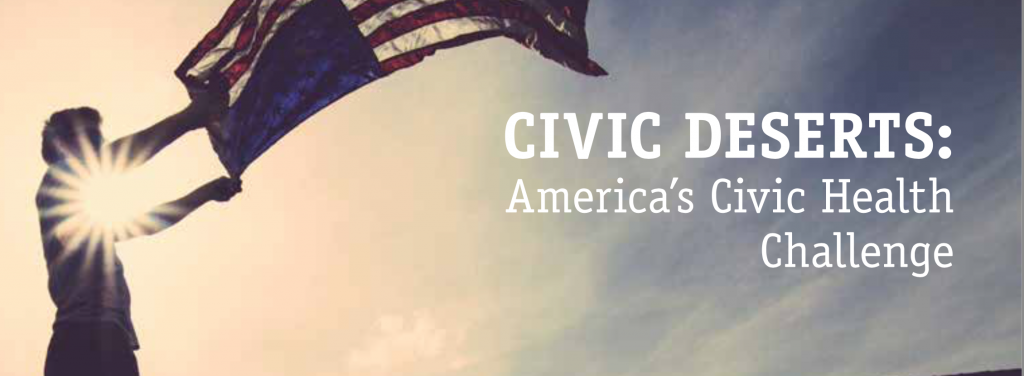
2017 was a big year for civic engagement. At the national level, we saw the inauguration of a new president, several major legislative debates, significant executive and regulatory actions like net neutrality, and protests and other forms of participation taking off across the political spectrum in response. On top of this, there was a seemingly endless presence of political issues in our news media and social media driving the conversation. And yet despite all of this, we now know that Americans are in many ways less civically engaged than ever before.
In October, the National Conference on Citizenship released a report detailing the decline in opportunities for civic engagement in America. The report’s title, Civic Deserts, reflects the finding that a large portion of our country’s population lives in places where engaging civically in a meaningful way is either difficult or impossible. Furthermore, many indicators of a civically healthy society are at their lowest levels ever. The implications of these findings for citizens and their local governments are especially important in today’s politically-charged environment.
The report builds on the work of Robert Putnam’s Bowling Alone in documenting the decline in participation in civic life over the past generation. Combining new updates to ongoing data sources with fully new approaches to measuring civic engagement, Civic Deserts paints a picture of a nation whose legacy and potential as a society shaped by grassroots involvement are profoundly at risk. Several key findings support this argument, including that:
- Americans are more politically polarized than ever before
- Americans are more socially isolated than ever before
- Trust in the press and media has plummeted
- Trust and confidence in government has plummeted
- Fewer Americans believe that people have a say in government, or that public officials care what people think, than ever before
- Americans are volunteering much less than they were ten years ago
Meanwhile, social media use has skyrocketed, and while there is some speculation that this could be replacing or improving upon other forms of engagement, it is ultimately still unclear if this development is helping or hurting engagement outcomes and development of social capital.
So how can local and state government leaders respond to these findings and support an American civic renewal? The report recommends three main paths:
- Improving American history and civics education;
- Expanding service opportunities; and
- Leveraging emerging technologies for engagement.
These are all great ideas that should be implemented at the local, state, and national levels as much and as quickly as possible.
At the same time, local and (to a lesser extent) state governments have an opportunity and a responsibility to improve the quality and quantity of civic engagement given their uniquely close connections to their citizens. Fortunately, there are more tools and models than ever before aimed at doing exactly that. Here are a few:
- Citizens academies are education and training programs that teach citizens about government and help shape them into local leaders.
- The Startup in Residence Program connects public sector departments and organizations with startup companies whose products and approaches improve public service delivery.
- The Code for America Brigade Network connects skilled civic tech volunteers with local governments to develop tools and solve problems.
- Citizen engagement platforms like Neighborland help local governments gather and respond to citizen ideas, feedback, and preferences.
- Social media is being used by local governments to connect with citizens in new and more effective ways: see some ideas here, here, and here (the last resource is free for ICMA members and $4.95 for non-members).
With these tools and others in hand, governments can take a proactive approach to increasing civic engagement that creates public value with and for the people.
How do you think local governments can better drive civic engagement in 2018 and beyond?
Great summary of the NCoC report. If I could add to the discussion one other possible solution: forums like Living Room Conversations or the Asteroids Club that are trying to bring community members together to bridge this growing ideological/trust/empathy divide. I plan on writing a post about a similar initiative that a friend and I have recently begun in Denver, but to the best of my knowledge projects like these do not receive much public funding or marketing. Even though studies show that they are among the best ways to build understanding between community members. This is not a panacea, but it’s really hard to not come away with at least a few positives about a person after a well-designed icebreaker and facilitated conversations (often over tea or coffee) that challenge some of the innate biases we hold and echo chambers/ideological bubbles we inhabit.